Related Research Articles

Universal Serial Bus (USB) is an industry standard that establishes specifications for cables, connectors and protocols for connection, communication and power supply (interfacing) between computers, peripherals and other computers. A broad variety of USB hardware exists, including 14 different connector types, of which USB-C is the most recent and the only one not currently deprecated since the release of USB 3.2.

A laptop computer or notebook computer, also known as a laptop or notebook for short, is a small, portable personal computer (PC). Laptops typically have a clamshell form factor with a flat panel screen on the inside of the upper lid and an alphanumeric keyboard and pointing device on the inside of the lower lid, although 2-in-1 PCs with a detachable keyboard are often marketed as laptops or as having a "laptop mode". Most of the computer's internal hardware is fitted inside the lower lid enclosure under the keyboard, although many laptops have a built-in webcam at the top of the screen and some modern ones even feature a touch-screen display. In most cases, unlike table computers which run on mobile operating systems, laptops tend to run on desktop operating systems which have been traditionally associated with desktop computers.

A DC connector is an electrical connector for supplying direct current (DC) power.

IEC 60320 Appliance couplers for household and similar general purposes is a set of standards from the International Electrotechnical Commission (IEC) specifying non-locking connectors for connecting power supply cords to electrical appliances of voltage not exceeding 250 V (a.c.) and rated current not exceeding 16 A. Different types of connector are specified for different combinations of current, temperature and earthing requirements. Unlike IEC 60309 connectors, they are not coded for voltage; users must ensure that the voltage rating of the equipment is compatible with the mains supply. The standard uses the term coupler to encompass connectors on power cords and power inlets and outlets built into appliances.
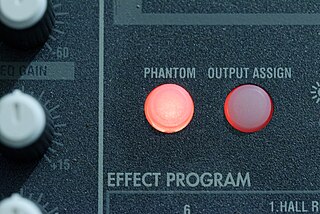
Phantom power, in the context of professional audio equipment, is DC electric power transmitted through microphone cables to operate microphones that contain active electronic circuitry. It is best known as a convenient power source for condenser microphones, though many active direct boxes also use it. The technique is also used in other applications where power supply and signal communication take place over the same wires.
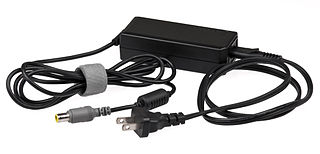
An AC adapter or AC/DC adapter is a type of external power supply, often enclosed in a case similar to an AC plug. Other common names include wall wart, power brick, wall charger, and power adapter. Adapters for battery-powered equipment may be described as chargers or rechargers. AC adapters are used with electrical devices that require power but do not contain internal components to derive the required voltage and power from mains power. The internal circuitry of an external power supply is very similar to the design that would be used for a built-in or internal supply.

USB On-The-Go is a specification first used in late 2001 that allows USB devices, such as tablets or smartphones, to act as a host, allowing other USB devices, such as USB flash drives, digital cameras, mouse or keyboards, to be attached to them. Use of USB OTG allows those devices to switch back and forth between the roles of host and device. A mobile phone may read from removable media as the host device, but present itself as a USB Mass Storage Device when connected to a host computer.
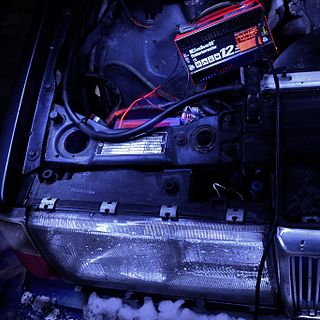
A battery charger, recharger, or simply charger, is a device that stores energy in a battery by running an electric current through it. The charging protocol depends on the size and type of the battery being charged. Some battery types have high tolerance for overcharging and can be recharged by connection to a constant voltage source or a constant current source, depending on battery type. Simple chargers of this type must be manually disconnected at the end of the charge cycle. Other battery types use a timer to cut off when charging should be complete. Other battery types cannot withstand over-charging, becoming damaged, over heating or even exploding. The charger may have temperature or voltage sensing circuits and a microprocessor controller to safely adjust the charging current and voltage, determine the state of charge, and cut off at the end of charge. Chargers may elevate the output voltage proportionally with current to compensate for impedance in the wires.

MagSafe is a series of proprietary magnetically attached power connectors developed by Apple Inc. for Mac laptops. MagSafe was introduced on January 10, 2006, in conjunction with the MacBook Pro, the first Intel-based Mac laptop, at the Macworld Expo. The connector is held in place magnetically so that if it is tugged it will pull out of the socket without damaging the connector or the computer power socket, and without pulling the computer off its surface. A thinner and wider version, called MagSafe 2, was introduced in 2012. It was discontinued across Apple's product lines between 2016 and 2019 and replaced with USB-C. MagSafe returned to Mac laptops with the introduction of updated MacBook Pro models with MagSafe 3 in 2021.

A power supply unit (PSU) converts mains AC to low-voltage regulated DC power for the internal components of a computer. Modern personal computers universally use switched-mode power supplies. Some power supplies have a manual switch for selecting input voltage, while others automatically adapt to the mains voltage.

A coaxial power connector is an electrical power connector used for attaching extra-low voltage devices such as consumer electronics to external electricity. Also known as barrel connectors, concentric barrel connectors or tip connectors, these small cylindrical connectors come in an enormous variety of sizes.

PoweredUSB, also known as Retail USB, USB PlusPower, USB +Power, and USB Power Plus, is an addition to the Universal Serial Bus standard that allows for higher-power devices to obtain power through their USB host instead of requiring an independent power supply or external AC adapter. It is mostly used in point-of-sale equipment, such as receipt printers and barcode readers.

USB 3.0, released in November 2008, is the third major version of the Universal Serial Bus (USB) standard for interfacing computers and electronic devices. Among other improvements, USB 3.0 adds the new transfer rate referred to as SuperSpeed USB (SS) that can transfer data at up to 5 Gbit/s, which is about 10 times faster than Hi-Speed. It is recommended that manufacturers distinguish USB 3.0 connectors from their USB 2.0 counterparts by using blue color for the Standard-A receptacles and plugs, and by the initials SS.
EmPower is a brand name that refers to three different power outlets available on commercial airlines:

Universal charger or common charger refers to various projects to standardize the connectors of power supplies, particularly for battery-powered devices.
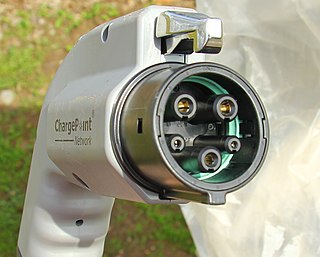
SAE J1772, also known as a J plug or Type 1 connector after its international standard, IEC 62196 Type 1, is a North American standard for electrical connectors for electric vehicles maintained by SAE International under the formal title "SAE Surface Vehicle Recommended Practice J1772, SAE Electric Vehicle Conductive Charge Coupler".
The common external power supply was a specification for a universal charger, made by the European Commission for smartphones sold within the European Union. Although compliance was voluntary, a majority of the world's largest mobile phone manufacturers agreed to make their applicable mobile phones compatible with the specification. The specification EN 62684:2010 was active from 2009 to 2014, and has since been withdrawn as obsolete.
The Universal Power Adapter for Mobile Devices (UPAMD), codename IEEE 1823-2015, is an IEEE standard for power supply design intended to cater to the power range of 10–130 W for mobile devices like laptop computers. The power supply was required to have an output capacitive energy of less than 15.1 µJ and an inductive energy at disconnect of less than 5.3 µJ.
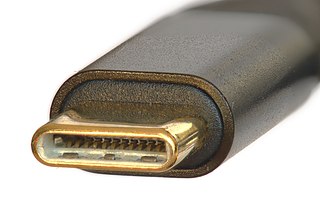
USB-C is a 24-pin USB connector system with a rotationally symmetrical connector. The designation C refers only to the connector's physical configuration or form factor and should not be confused with the connector's specific capabilities, which are designated by its transfer specifications. A notable feature of the USB-C connector is its rotational symmetry; a plug may be inserted into a receptacle in either orientation.
The initial versions of the USB standard specified connectors that were easy to use and that would have acceptable life spans; revisions of the standard added smaller connectors useful for compact portable devices. Higher-speed development of the USB standard gave rise to another family of connectors to permit additional data paths. All versions of USB specify cable properties; version 3.x cables include additional data paths. The USB standard included power supply to peripheral devices; modern versions of the standard extend the power delivery limits for battery charging and devices requiring up to 100 watts. USB has been selected as the standard charging format for many mobile phones, reducing the proliferation of proprietary chargers.
References
- ↑ "Major milestone: single charger for notebook computers will significantly reduce e-waste". IEC. Archived from the original on 24 December 2013.
- ↑ "IEC presses for single charger specification for notebook computers". EDN Europe. 18 December 2013.
- ↑ "IEC TS 62700:2014 | IEC Webstore".